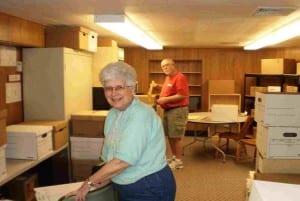Moving West (actually it was south)
Two years ago, the North Canton Heritage Society found out that its home for the last thirteen years, the 1929 North Canton High School building, was to be torn down. Uh oh, I thought. This means we have to move.

If you thought moving your house was hard, try moving a historical society—with its collections, exhibits, office equipment, etc.—and staying open at the same time. I’m proud to say we did it with a lot of organization, hard work and lots of volunteer help. We were only closed one week and have been in our new location since April 30.
I thought I would share some pointers, in case you ever have to move your museum (and I hope you never have to).
The biggest one is organization. I’ll say that one again – organization. You need to plot out a scenario. What gets moved, and when does it get moved? How should it be packed? Who should pack it? How should it be moved – can it go on a truck, or should it be moved by hand? We took our time in packing, doing a little each day. Then, we had a packing day a week before the planned move with board members and volunteers packing up the items we used most often (library books, files, cleaning supplies, etc.). I also packed a mobile office box with items I knew I’d need right away, like the checkbooks, a calculator, pens, paper, scotch tape, my Rolodex and other stuff.
Our small museum includes exhibits, collections in storage, a library/archives and an office. As we packed these areas, I used color-coded dots to indicate what box went to which part of the new facility – red for collections, yellow for office, etc.
Next, I made a floor plan of our new digs. A wonderful new volunteer, Maggie, who has a graduate degree in museum design (how lucky is that?), helped me position the showcases and other furniture. We measured the footprint of everything and used graph paper cutouts to position each item. Maggie then used the cutouts to design a layout using computer-aided design (CAD) software. We numbered the cases, desks and file cabinets and taped these numbers on each fixture. We then went to the new offices and laid out each item, marking the corners with tape. This way, the movers knew just where to put everything.
We decided to relocate our main museum exhibit, a timeline, so visitors would have something to see when we reopened. We packed items in separate boxes, each labeled with the appropriate case number. We then put into storage the other items on display at the old building.
This brings me to the collection storage area. Everything I’ve read about moving a collection says that you should, if you can, do it slowly. We moved some of the collection during our big move, but we would still be organizing boxes today if we’d moved it all that same day. Luckily, we could take our time. As all of our storage shelves are numbered and the boxes on each shelf numbered as well (corresponding to computerized collection records in PastPerfect), we decided to move one shelving unit at a time. We have some nice wire shelving that just knocks together. We bought one new unit so we could move the contents of a shelf to the new unit, take the old shelving unit to the new location, then repeat the process. We used our colored dots again, the same color on all of the boxes from each shelving unit.
We were very lucky to have a moving company do our relocation. Both our board and volunteers are a bit on the older side of life, and we could not expect them to help move our heaviest items. The board decided just to see how much it would cost to hire a moving company. The first company I called, Two Men and a Truck, offered to move us for FREE. I almost cried. They were wonderful and so strong. Don’t assume you have to do it all yourself. Ask, and oftentimes, you will receive.
So that’s the story of our move, so far anyway. We are continuing to take our time, and we won’t have a public open house until August during the city’s street festival. If you ever need to relocate your museum, lots of luck. I hope you will, as we did, have lots of time to plan.
Kathy Fernandez is treasurer of the Ohio Local History Alliance and executive director of the North Canton Heritage Society.
